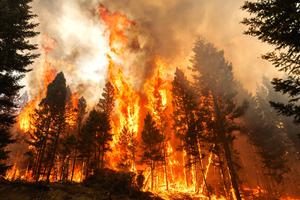The pronghorn, a close relative of the antelope, is the fastest mammal in North America and an iconic creature in the American West, where an estimated 700,000 roam the high desert and plains. In recent years, however, intensive development — including a natural gas drilling boom in Wyoming and Colorado — has begun to eat away at the pronghorn’s territory.
In a video report for Yale Environment 360, “End of the Range: Plight of the Pronghorn,” journalists Daniel Glick and Ted Wood, of The Story Group, examine the fate of one small herd of pronghorn that has migrated for more than 6,000 years from the Grand Teton Mountains in Wyoming to their wintering grounds. The several hundred pronghorn that still make the 160-mile round-trip migration now face an obstacle course of drilling pads, roads, fences, and new subdivisions.
The threats to this small band of pronghorn — part of the 46,000-strong Upper Green River Valley herd — prompted the U.S. Forest Service in 2008 to officially designate a section of the migration route as a federally protected migration corridor; scientists and conservationists now want that protection extended to the rest of the migration route. As Glick notes, “The West’s iconic landscapes and animals are paying a steep price for our energy addictions.”
video
Pronghorn Herd Faces Obstacles from Natural Gas Boom in Rocky Mountain West
The pronghorn, a close relative of the antelope, is the fastest mammal in North America and an iconic creature in the American West, where an estimated 700,000 roam the high desert and plains. In recent years, however, intensive development has begun to eat away at the pronghorn’s territory. In a video report for Yale Environment 360, journalists Daniel Glick and Ted Wood examine the fate of a herd of pronghorn that has migrated for more than 6,000 years from the Grand Teton Mountains to their wintering grounds.
More From E360
-
INTERVIEW
On Controlling Fire, New Lessons from a Deep Indigenous Past
-
Solutions
Paying the People: Liberia’s Novel Plan to Save Its Forests
-
OPINION
Forest Service Plan Threatens the Heart of an Alaskan Wilderness
-
INTERVIEW
Pakistan’s Solar Revolution Is Bringing Power to the People
-
Food & Agriculture
In Uganda, Deadly Landslides Force an Agricultural Reckoning
-
Energy
Why U.S. Geothermal May Advance, Despite Political Headwinds
-
Food & Agriculture
In War Zones, a Race to Save Key Seeds Needed to Feed the World
-
Climate
Lightning Strikes the Arctic: What Will It Mean for the Far North?
-
RIVERS
A Win for Farmers and Tribes Brings New Hope to the Klamath
-
Solutions
Deconstructing Buildings: The Quest for New Life for Old Wood
-
NATURAL DEFENSES
How Restored Wetlands Can Protect Europe from Russian Invasion
-
Solutions
Birds vs. Wind Turbines: New Research Aims to Prevent Deaths

